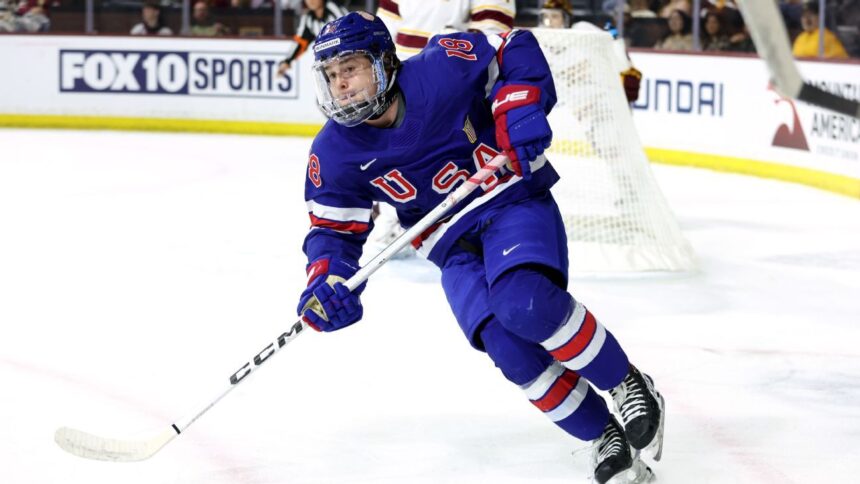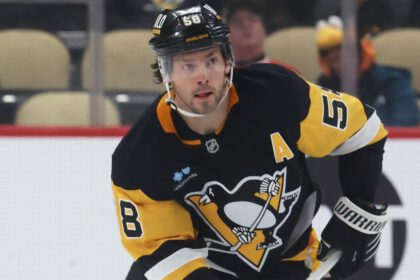In each NHL Draft, it is common to find valuable players in late rounds who end up having impactful careers. Although talent analysis and scouting have improved, “diamonds in the rough” always emerge in the final rounds. It is no longer common to find players like Pavel Datsyuk, Henrik Lundqvist or Brett Hull in the final rounds. However, smaller players with great skill are often selected later. Lane Hutson, the current winner of the Calder Trophy, was not a late selection (62nd in 2022), but his talent deserved a higher position.
Some recent examples of valuable players in late rounds include Troy Terry (148th in 2015), Andrew Mangiapane (166th in 2015), Jesper Bratt (162nd in 2016), Brandon Hagel (159th in 2016), and Mark Stone (178th in 2010). All of them had certain doubts during the selection process, whether due to their size, skating, or the adaptation of their game to the NHL. However, they exceeded expectations and represented their countries internationally. The draft position does not determine success, but players selected earlier have more opportunities, while those from later rounds must earn them.
The common factor in the success of these players is that they excel in at least one key skill. As an NHL executive said, “they possess a distinctive skill that sets them apart from the rest.” This year, there are several players who could become those “hidden gems.” Statistically, a player selected after the third round has less than a 3% chance of playing 200 games in the NHL, so it’s likely that only four or five players after the 96th pick will achieve this. The probability of them becoming impactful players is less than 1.5%, not including goalies. Although the bets are risky, some players in this class have skills that could increase their chances.Cameron Schmidt, Right Wing, Vancouver Giants (WHL)
Despite Schmidt being well-positioned in the public rankings, and remaining a first-round selection in many of them, NHL teams don’t see him the same way. Many scouts believe he will be selected between the third and fifth rounds due to his height, which is less than that of an average NHL player (5’7″).
However, Schmidt’s potential as a second-line scoring winger, similar to Alex Debrincat, should excite teams. It is understandable that teams hesitate to select a player of his stature in the early rounds, given the low probability of success for players under 5’9″. Schmidt is possibly the fastest player in the draft, with an elite shot. He possesses more than one “distinctive skill” that scouts look for, and some believe that, if he were 6’1″, he could be in the conversation to be selected between the 10-15 spots. With 40 goals in 61 games, he is one of the best scorers available in the draft. He can score in several ways: on the run, with direct shots, finishing in front of the goal and with a soft but powerful shot. Schmidt is likely to lead the CHL in goals in the next two seasons, thanks to his speed and finishing ability. Debrincat is 5’8″, and if Schmidt reaches that height or even 5’9″, there’s a great possibility he’ll become a reliable scorer in the NHL. Instead of prioritizing physical strength and size, taking a chance on someone who already has elite talent could be very rewarding for a team.Jacob Rombach, Defense, Lincoln Stars (USHL)
A nearly 6’7″ defenseman with imposing physical qualities and the potential to become a solid defender will be very attractive to teams. Rombach lacks the offensive skill that teams look for in their high-level defensemen, but he has a clear path to becoming a 4/5 level defenseman in the NHL. Defensively, he possesses one of the most complete skill sets in the draft, which will only improve as he refines them. He has an impressive ability to retrieve the puck, scanning for threats and allowing him to anticipate pressure situations. He uses head fakes to evade forechecking players and makes simple, efficient passes when space opens up. In defense, he uses his physique to interrupt running plays, stop them at the wall, and make it difficult for teams to generate play. He is not excessively physical, and although that is something that can be developed with his size, scouts like that he doesn’t get out of position trying to make a big hit. When he closes the spaces to the players all over the court, he leads with a strong stick and suffocates them, forcing turnovers or sending the ball to the back. If he improves his skating and his physique, Rombach has the tools to be an effective defenseman who can kill penalties and play in secondary matchups.David Bedkowski, Defense, Oshawa Generals (OHL)
Old-school hockey fans adore Bedkowski for his taste for aggression. He is an old-school player in the sense that he lives for violence. He is a menacing defenseman of almost 6’5″ and 215 pounds, and he is the most punishing defenseman of the draft class. Although that doesn’t always translate into NHL success, the Florida Panthers’ model will surely make executives think about Bedkowski’s ability to play very effective transition defense and inflict great pain on opponents with his physical play. He’s one of the best post entry defenders in the draft, and if he can better choose his moments to make contact, he has the potential to become an effective defender in a lower pairing. His potential is not high in terms of becoming a 4/5 level player, but teams need depth and brute strength to win in the playoffs, and Bedkowski can become a defenseman who can reliably provide that.
Viktor Klingsell, Left Wing, Skelleftea AIK (J20)
Another candidate to be a bargain in later rounds is Klingsell, who stood out in the U18 World Championship. He didn’t produce at Jesper Bratt’s level in Sweden, but he outperformed Bratt when playing against his peers. Given the similarity in height, playmaking, and high-level vision, it’s not surprising that some believe Klingsell could be a “Bratt lite” in the NHL. He lacks physical strength, which is not surprising given his stature, but his instincts and offensive toolkit are among the best available among European skaters. The main concern is his pace. Klingsell has an “all or nothing” type profile. If he succeeds, he will be a second-line offensive facilitator who will accumulate more than 50 assists each year. If he doesn’t, he’s likely to become a very good SHL player. That’s the kind of bet you make in later rounds, especially when speed is the concern. But it’s much easier to develop skating and speed than to find a player with the natural offensive instincts and playmaking abilities that Klingsell possesses.Filip Ekberg, Left Wing, Ottawa 67’s (OHL)
Another Swede with the potential to make a team very happy is the dual-threat forward Ekberg. The first half of the season was plagued by illness and a limited role. As the calendar turned, Ekberg’s game took off, culminating in a standout performance in the U18, where he scored 18 points in seven games and earned an invitation to Sweden’s summer team for the Junior World Cup.
There is a real reason to believe that Ekberg is about to have a major scoring breakthrough in the OHL that would propel his projection to a mid-level scorer in the NHL. Ekberg is a complete forward, anticipates and reads the game, facilitates the offense, and possesses an excellent shot and reception. He lacks the dynamism you’d like to see, but showed legitimate flashes of skill when healthy in the U18. If he can improve his skating, he has all the characteristics of a smaller player who can succeed in the NHL, in a secondary scoring role and on the power play.









